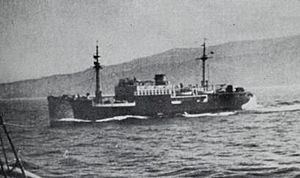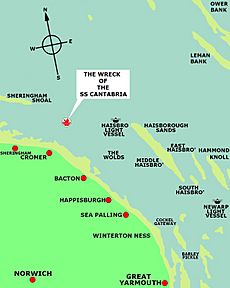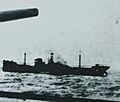SS Cantabria (1919) facts for kids

Cantabria sinking, photographed from
the Nationalist cruiser Nadir |
|
Quick facts for kids History |
|
|---|---|
| Name |
|
| Owner |
|
| Operator |
|
| Port of registry | Santander |
| Builder | J Coughlan & Sons, Vancouver |
| Launched | 19 August 1918 |
| Completed | February 1919 |
| Identification | |
| Fate | sunk by gunfire, 2 November 1938 |
| General characteristics | |
| Tonnage | 5,743 GRT, 4,180 NRT |
| Length | 410.5 ft (125.1 m) |
| Beam | 54.1 ft (16.5 m) |
| Depth | 27.5 ft (8.4 m) |
| Decks | 2 |
| Installed power | by 1926: 532 NHP |
| Propulsion |
|
| Speed | 8–10 knots (15–19 km/h) |
| Crew | 33 |
The SS Cantabria was a Spanish cargo ship that sailed the seas. It was built in Canada in 1919. Sadly, it was sunk in 1938 during a battle at sea in the Spanish Civil War. This happened in the North Sea. The ship had a few names during its life: it started as War Chief, then became Alfonso Pérez, and finally Cantabria during the war.
The Cantabria's sunken remains are located off the coast of Norfolk, about 12 miles northeast of Cromer. It was attacked and sunk by shells from a Spanish Nationalist warship called the Nadir.
Contents
Building and Early Life of the Ship
The ship was built by J Coughlan & Sons in Vancouver, British Columbia, Canada. It was originally named War Chief and was made for the UK Shipping Controller. The ship was launched on August 19, 1918, and finished being built in February 1919.
The Cantabria was about 410.5 ft (125.1 m) long, 54.1 ft (16.5 m) wide, and 27.5 ft (8.4 m) deep. It weighed 5,743 GRT gross tons. At first, it had a steam turbine engine. By 1926, this was changed to a different type of steam engine that was quite powerful.
The War Chief was first managed by Raeburn and Vérel from Glasgow. But by mid-1919, it was sold to AF Pérez. He renamed the ship Alfonso Pérez and registered it in Santander. The ship used special code letters for identification. Later, it also got a call sign for radio communication.
In 1934, during a miners' strike in Spain, the Alfonso Pérez was used as a prison ship. This means it held prisoners on board. In 1937, the Spanish Republican government took control of the ship and renamed it Cantabria. They also used it as a prison ship in Santander.
The Sinking of the Cantabria
By 1938, the Cantabria was being rented by a British company in London. It was not involved in Spanish trade at that time. The ship was traveling without cargo from the River Thames to Immingham. From there, it was supposed to go to Leningrad (now St. Petersburg, Russia). Captain Manuel Argüelles was in charge.
There were 33 crew members and eight passengers on board. Five of the passengers were children, and three were women. Captain Argüelles' wife, Trinidad, and their two children, Ramon (6 years old) and Begoña (8 years old), were among the passengers. There was also another 3-year-old child.
The Nadir Warship
The Nadir was a warship used by the Spanish Nationalist navy. It was an auxiliary cruiser, meaning it was a merchant ship changed into a warship. It had a large main gun and several smaller guns. The Nadir was originally a merchant ship called Ciudad de Valencia. The Nationalists renamed it to trick the other side in the war about how many warships they had. Its job was to stop Republican cargo ships in northern Europe.
The Attack at Sea
Nazi Germany allowed Spanish Nationalist ships to use the port of Emden as a base. From there, they could attack Spanish Republican ships in the North Sea and the English Channel.
Around 11:30 AM on November 2, Captain Argüelles noticed another ship following the Cantabria. He changed course slightly, and the other ship followed. His officers looked at the ship with binoculars. It looked like a normal passenger ship.
But the ship following them was actually the Nadir. Captain Argüelles changed course again, heading towards the coast of Norfolk. The Nadir kept following and sped up. In the afternoon, the Cantabrias crew saw the Nadirs crew raise the Spanish Nationalist flag. At the same time, the Nadir showed its guns and signaled, "Stop or I fire." Then, the warship started shooting.
This attack happened in international waters, which means it was outside British waters. However, it was close enough to the coast that people on land could see it. Captain Argüelles said he refused to stop the Cantabria even after the Nadir fired a warning shot.
Some nearby fishing boats saw what was happening. They bravely headed towards the Nadir and sounded their sirens. This made the warship change course and stop its attack. The fishing boats thought they had ended the danger and continued on their way.
However, after the fishing boats left, the Nadir returned and started firing at the Cantabria again. A shell hit the Cantabria's bridge, destroying it. The warship circled the Cantabria, firing shells and shooting with machine guns. A shell also hit the engine room, making the Cantabria unable to move.
The Cantabria's radio operator had been sending messages saying the ship was "being shelled by unknown vessel." After the bridge was destroyed and the engine stopped, he sent an SOS signal. He gave the ship's location as 8½ miles southeast of the Haisbro Light Ship.
Rescue Efforts
It was getting dark. At 5 PM, the Cromer Lifeboat H F Bailey, led by coxswain Henry Blogg, was launched to rescue the people on the Cantabria. Before the lifeboat arrived, fire spread through the ship. Two lifeboats were lowered, and some crew and passengers left the ship. Captain Argüelles, his wife and children, and the second steward, Joaquin Vallego, stayed on board. They were worried about what would happen if they surrendered to the Nadir. When the lifeboats were lowered, the Nadir stopped firing.
Two cargo ships, the British Monkwood and a Norwegian ship, saw the attack. But they did not try to rescue anyone. They were afraid of the Nadir, which was still in international waters. The Monkwood later reported the incident to the naval authorities. British naval units were then sent to the area to make sure no attacks happened inside British waters.
Another British merchant ship, the Pattersonian, came to help after hearing the Cantabria's SOS. Captain Blackmore of the Pattersonian saw the Nadir heading towards the lifeboat. He steered his ship to block the Nadirs path, stopping it from reaching the lifeboat. The Pattersonian rescued eleven crew members from the Cantabrias lifeboats. The Nadir captured 20 crew members from the second lifeboat. This was later judged to be against the law, as the Nadir stopped a rescue mission.
It was now dark, and no more shots were being fired. The H F Bailey lifeboat arrived at the scene at 6:30 PM. Captain Argüelles signaled the lifeboat with a flashlight. The lifeboat pulled alongside the Cantabria, which was leaning heavily to one side. A rope was thrown, and the children and Captain Argüelles' wife were carefully passed down to the lifeboat. Then the steward and Captain Argüelles followed.
Once everyone was rescued, the Cantabria suddenly tipped over, damaging the lifeboat. The H F Bailey quickly moved away from the Cantabria, which sank soon after. At least one sailor, Juan Gil, was lost with the ship. Other reports say four crew members were lost.
After the Sinking
The H F Bailey lifeboat returned to Cromer, arriving at 8:15 PM. Captain Argüelles, his family, and the steward were taken to a hotel. The Pattersonian took the other 11 rescued crew members to Great Yarmouth. The BBC reported on the incident and warned other ships about the sunken Cantabria's location. British newspapers made the story headline news. However, many of the rescued crew members in Yarmouth did not want their pictures taken, fearing what the Nationalists might do to them. Questions about the incident were asked in the British Parliament.
Here are some of the people rescued:
- By the H F Bailey lifeboat: Captain Manuel Argüelles, Trinidad Argüelles, Ramón Argüelles (aged 6), Begoña Argüelles (aged 8), and Joaquín Vallego.
- By the Pattersonian: José López, Pedro García, Francisco Pou, Francisco García, Fernando Manciro, Rafael Leou, Hilaro Trilear, Santiago Glorente, Román Amorebieta, Armando Abad, and Manuel Figuciras.
- Captured by the Nadir: 24 crew members, including Eduardo Collade (the radio operator), his wife, and their two children.
Spying and the Attack Plan
Two weeks after the Cantabria sank, Danish police shared information that showed the attack was not just a coincidence. For some time, the Danish police had been watching German newspaper reporters in Copenhagen. One of them was Horst von Pflugk-Harttung. He worked for a German newspaper that was connected to the German military. Danish police arrested Harttung and eight other Germans in Denmark, along with three Danes. They were accused of being spies in Copenhagen.
The Danish police found that these people had been trained at Gestapo (German secret police) spy schools. They had secret radio stations and were gathering information about ships and sea maps. They used complex codes to communicate. All this spying showed that Nazi Germany was preparing for war. The attack on the Cantabria was used to show how complicated the spy network was. The sinking was planned by the Spanish Nationalists, with help from their allies, as a warning to Britain. It was meant to tell the British government that if they didn't cooperate, worse things could happen. The Danish police investigation proved that Nazi Germany had planned the attack. As mentioned, the Nadir and its sister ship used Emden, a German port, as a supply base.
Horst von Pflugk-Harttung
Horst von Pflugk-Harttung was a German spy. He and his brother Georg had previously been accused in Berlin of being involved in the deaths of Socialist leaders, Karl Liebknecht and Rosa Luxemburg. Both brothers were found not guilty, but many people still thought they were involved. Georg was later killed. After Horst von Pflugk-Harttung's trial in Denmark, he was sentenced to only a year and a half in prison. He was released after a few months because the German government put pressure on Denmark. He later became a top German intelligence leader in Denmark.
A Tribute in 2006
Captain Manuel Argüelles and his wife Trinidad later moved with their children to Mexico. In 2006, a new museum for the Henry Blogg lifeboat was opened. Captain Argüelles' son Ramón and daughter Begoña visited the museum to honor Henry Blogg and his brave crew who rescued them.
Images for kids
See also
 In Spanish: Cantabria (1937) para niños
In Spanish: Cantabria (1937) para niños






